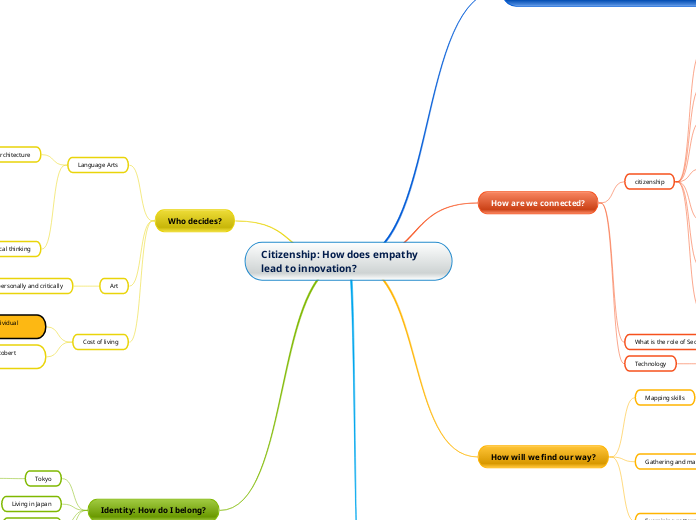Citizenship: How does empathy lead to innovation?
How are people included and excluded from our community?
Design thinking
What are some of the challenges of "rough sleep"?
What Do You Do with a Problem? by Kobi Yamada
What resources are available in our community?
Food Security
How are we connected?
citizenship
D2.Civ.2.3-5. Explain how a democracy relies on people’s responsible participation, and draw implications for how individuals should participate.
D4.1.3-5. Construct arguments using claims and evidence from multiple sources.
D4.2.3-5. Construct explanations using reasoning, correct sequence, examples, and details with relevant information and data.
D4.3.3-5. Present a summary of arguments and explanations to others outside the classroom using print and oral technologies (e.g., posters, essays, letters, debates, speeches, and reports) and digital technologies (e.g., Internet, social media, and digital documentary).
D4.7.3-5. Explain different strategies and approaches students and others could take in working alone and together to address local, regional, and global problems, and predict possible results of their actions.
D4.6.3-5. Draw on disciplinary concepts to explain the challenges people have faced and opportunities they have created, in addressing local, regional, and global problems at various times and places.
D4.8.3-5. Use a range of deliberative and democratic procedures to make decisions about and act on civic problems in their classrooms and schools.
Maddi’s Fridge by Lois Brandt https://www.youtube.com/watch?v=To07TjBnrNY
What is the role of Second Harvest in our community?
Technology
Help Share the story
How will we find our way?
Mapping skills
D2.Geo.1.3-5. Construct maps and other graphic representations of both familiar and unfamiliar places.
Gathering and manipulating data
Book: IF: A Mind Bending New Way of Looking at Big Ideas and Numbers by David Smith, illustrated by Steve Adams
Make a big idea small: Have students poll one another or several other classes about demographics; ask about gender, age, background, family structure, etc. Have students map out these demographics on charts; what percent of our class was born in Canada? How many students are female? Work with the class to reduce information to a smaller number, e.g. “If all the grade 6 students at our school were represented by 10 people…” Use this concept to create infographics about global poverty, homelessness in Japan, food insecurity, or other social issues
Examining patterns and relationships
School based connections
Experts in the community
Neighborhood walking tour
examine architecture
Evidence of citizenship within the neighborhood
Other resources
Books
Videos
Who decides?
Language Arts
Perspective taking: Hostile Architecture
Second Harvest
former clients
architects
D2.Civ.10.3-5. Identify the beliefs, experiences, perspectives, and values that underlie their own and others’ points of view about civic issues.
D3.3.3-5. Identify evidence that draws information from multiple sources in response to compelling questions.
D3.4.3-5. Use evidence to develop claims in response to compelling questions.
Historical thinking
Art
Responding personally and critically
Photo Essay: How does childhood hunger affect the lives of children in Tokyo? https://docs.google.com/document/d/1D4Ohm4hZZFfXolLe57HC5nI9G-N_YpUcY5d9gGsJutU/edit
Cost of living
D2.Eco.1.3-5. Compare the benefits and costs of individual choices.
The Lunch Thief by Anne C. Bromley, illustrated by Robert Casilla
Identity: How do I belong?
Tokyo
The Hundred Dresses Eleanor Estes, illustrated by Louis Slobodkin
Living in Japan
Global Citizen
Volunteerism
